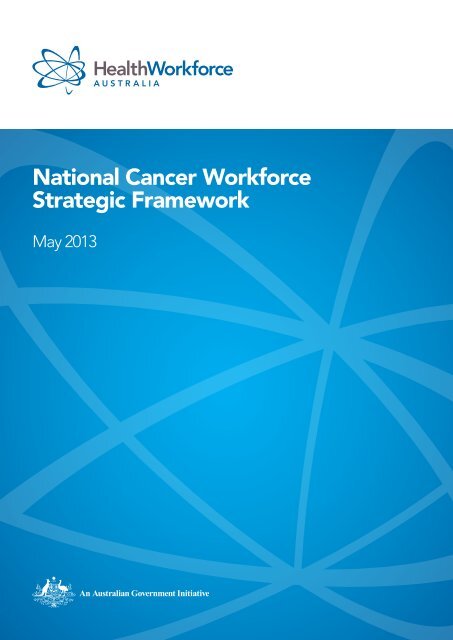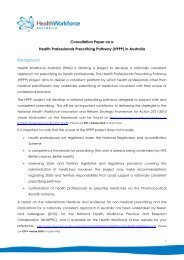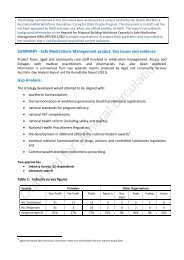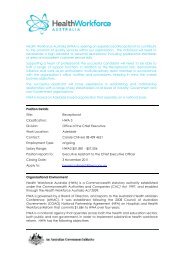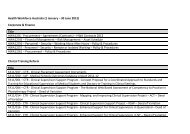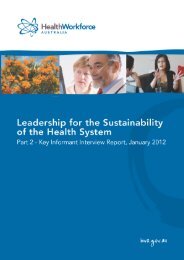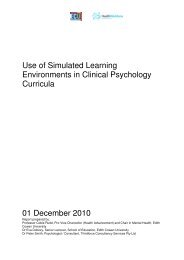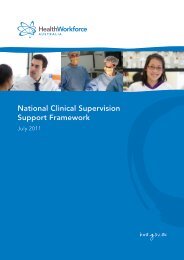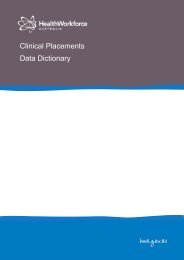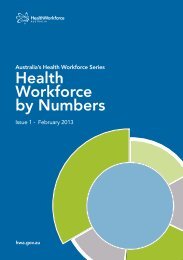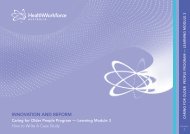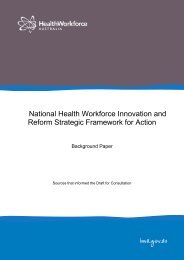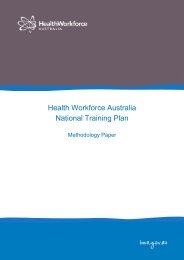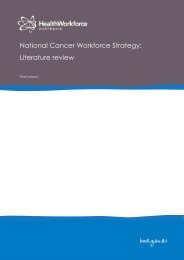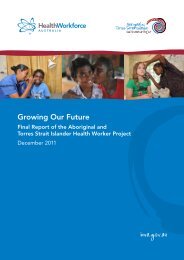National Cancer Workforce Strategic Framework - Health Workforce ...
National Cancer Workforce Strategic Framework - Health Workforce ...
National Cancer Workforce Strategic Framework - Health Workforce ...
- No tags were found...
You also want an ePaper? Increase the reach of your titles
YUMPU automatically turns print PDFs into web optimized ePapers that Google loves.
ContentsExecutive summary 3Introduction 5The case for cancer workforce change 11The <strong>National</strong> <strong>Cancer</strong> <strong>Workforce</strong> <strong>Strategic</strong> <strong>Framework</strong> 15Time for action – the <strong>National</strong> <strong>Cancer</strong> <strong>Workforce</strong> <strong>Strategic</strong> <strong>Framework</strong> domains 18<strong>National</strong> <strong>Cancer</strong> <strong>Workforce</strong> <strong>Strategic</strong> <strong>Framework</strong> domain 1 20<strong>National</strong> <strong>Cancer</strong> <strong>Workforce</strong> <strong>Strategic</strong> <strong>Framework</strong> domain 2 25<strong>National</strong> <strong>Cancer</strong> <strong>Workforce</strong> <strong>Strategic</strong> <strong>Framework</strong> domain 3 30<strong>National</strong> <strong>Cancer</strong> <strong>Workforce</strong> <strong>Strategic</strong> <strong>Framework</strong> domain 4 34<strong>National</strong> <strong>Cancer</strong> <strong>Workforce</strong> <strong>Strategic</strong> <strong>Framework</strong> domain 5 39Glossary 42References 47<strong>National</strong> <strong>Cancer</strong> <strong>Workforce</strong> <strong>Strategic</strong> <strong>Framework</strong> | HWA 3
Executive summary<strong>National</strong> <strong>Cancer</strong> <strong>Workforce</strong> <strong>Strategic</strong><strong>Framework</strong><strong>Health</strong> <strong>Workforce</strong> Australia’s (HWA) role has beento develop a <strong>National</strong> <strong>Cancer</strong> <strong>Workforce</strong> <strong>Strategic</strong><strong>Framework</strong> (NCWSF) that offers a course of action toaddress workforce issues for the cancer control sector,and also identify key innovations and reforms withpotential national application.The purpose of the NCWSF is to provide a set ofstrategic options for adoption at national, jurisdictionaland cancer organisation level, to add value to whatis already underway, and to facilitate shifts to a moreeffective way of working.<strong>Health</strong> <strong>Workforce</strong> Australia believes the NCWSF shouldbe incorporated into national cancer care initiatives andestablished cancer control service delivery planning,including the Regional <strong>Cancer</strong> Centres. <strong>Cancer</strong> expertsconsulted in the development of the NCWSF indicate itwill add value to the considerable investment in cancerinfrastructure by all governments.NCWSF visionA right-skilled cancer workforce delivering safe, effective,consumer-centred care in the most appropriate settingwhich:• Operates to its full scope of practice.• Is flexible to changing requirements.• Uses expert clinical staff in the most efficient andeffective manner.• Eliminates unnecessary duplication of activities forconsumers at all points of care.What would achieving this vision look like?• The cancer workforce is planned on the basis ofconsumer and community need.• The skill and capacity of the whole cancer workforce ismaximised to provide optimal care.• All workforce innovation and reform activities addvalue to the successes and strengths of the currentsystem of cancer control.• Multi-disciplinary team care, clinical leadership, and anintegrated team approach continue to be fundamentalto cancer clinical care, service delivery and workforceplanning.• The importance of consumers, volunteers and unpaidcarers is recognised in cancer workforce planning.• The acknowledgement that cancer is largely a chronicdisease.• All workforce innovation and reform activities includeethical consideration regarding appropriateness oftreatment and seamless transition to palliative care forthe ageing population.• Priority is given to Australia’s social and culturaldiversity and the promotion of equity of access andoutcomes across communities, geographic areas andage groups, especially Aboriginal and Torres StraitIslander people and those from rural, regional andremote areas.• Reform of the cancer workforce integrates with thebroader health and education reforms.• Innovation and reform is supported by robustmonitoring and evaluation processes.4HWA | <strong>National</strong> <strong>Cancer</strong> <strong>Workforce</strong> <strong>Strategic</strong> <strong>Framework</strong>
All governments and many non-governmentorganisations have made a sustained effort andconsiderable investment in promoting preventionprograms and interventions to reduce preventablechronic diseases, including cancer. Among othermeasures, the <strong>National</strong> Partnership Agreement onPreventative <strong>Health</strong> 5 provides for interventions inschools, workplaces and communities to supportphysical activity, improved diets, healthy weight andincreased quit smoking programs. While much successfulwork has been done in cancer prevention, continuedeffort is needed.<strong>Cancer</strong> service capabilities in Australia are constrainedby many features including diverse geography andthe inherent challenge of attracting and retaining asufficient skilled workforce. <strong>Cancer</strong> treatments requirehighly technical and specialised health professionals.Rural and regional areas have had particular difficulty inattracting and retaining sufficient specialist cancer healthprofessionals. HWA is undertaking work around the ruraland remote workforce; developing a strategy containing23 recommendations.HW2025’s position is that the development andimplementation of a plan to close any gaps is the key tothe creation of a sustainable workforce. There are threeprimary levers through which this can occur:• Reform: this may include changes to scopes ofpractice, increased use of assistants, the introductionof new workforce or workforce models, and broaderapplication of technologies such as e-<strong>Health</strong> andtelehealth.• Training: this may involve reforms to the educationpathway, interventions to ensure particular skills aredeveloped for the future or training new types ofworkforce.• Immigration: this is often used as a short-termdemand-management strategy. Over a longerplanning horizon, better management of migrationpathways for international health professionals canoccur in combination with training and reform.Australia’s health system is highly reliant on internationalhealth professionals (IHPs) to provide health services tothe community. The proportion of international medicalgraduates is significantly higher in rural, regional andremote areas, where 41 per cent of all doctors havetrained overseas (up to 70 per cent in some communities).HW2025 highlights the likely ongoing demand foremployment of international health professionals, at leastin the short to medium term, as part of a comprehensivestrategy to meet projected health demands.Encouraging and supporting participation in the healthworkforce by the Aboriginal and Torres Strait Islanderpopulation and focusing strongly in its development andretention must be a priority in future health workforcereform. HWA has recently undertaken work to strengthenand sustain the Aboriginal and Torres Strait Islanderhealth workforce to deliver care in response to the knownburden of disease in Aboriginal and Torres Strait Islandercommunities. The final report on the HWA projectmakes 27 recommendations and HWA is facilitating animplementation plan based on these recommendations.<strong>Cancer</strong> care is most effectively delivered by a skilledcancer workforce able to deliver multi-disciplinary teamcare in a range of settings, with effective role delineationand coordinated treatment. Effective use of the wholespectrum of required health professionals across thevarious stages of the cancer journey is essential foroptimal outcomes, good support for people affectedby cancer and their families as well as the efficient use ofa sparse workforce. It is widely recognised that the bestworkforce approach is health professionals working in astructured team environment that enables appropriatedelegation of clinical activities and formalisedcommunication of treatment plans and decisions. In thisway, patients and people affected by cancer can accessthe care they need in a timely manner without necessarilyhaving to see multiple health professionals working indiscrete and demarcated roles and settings.The establishment of Regional <strong>Cancer</strong> Centres is onemechanism which will help to address the pooreroutcomes experienced by some cancer patients, providebetter support for people affected by cancer and theirfamilies living in rural, regional and remote communities.Services will align with state and territory cancer plansand focus on identified patient treatment gaps througha collaborative network of linked private and publicservices, both locally and nationally, to provide qualitymultidisciplinary care for patients.<strong>National</strong> <strong>Cancer</strong> <strong>Workforce</strong> <strong>Strategic</strong> <strong>Framework</strong> | HWA 11
It is timely, therefore, to develop a <strong>National</strong> <strong>Cancer</strong><strong>Workforce</strong> <strong>Strategic</strong> <strong>Framework</strong> that aligns withincreasing cancer incidence, new technology, a stretchedworkforce and increasing consumer expectations.However, effective workforce strategies have a long leadtime and require considerable planning and investment.These strategies will need to address aggregatedworkforce numbers as well as appropriate investigationof the workforce composition, new models of care androle delineation.What would successful cancer workforcechange look like?• All workforce innovation and reform activities addvalue to the successes and strengths of the currentsystem of cancer control.• The cancer workforce is planned on the basis ofconsumer and community need.• The skill and capacity of the whole cancer workforce ismaximised to provide optimal care.• Multi-disciplinary team care, clinical leadership, and anintegrated team approach continue to be fundamentalto cancer clinical care, service delivery and workforceplanning.• The importance of consumers, volunteers and unpaidcarers is recognised in cancer workforce planning.• Priority is given to Australia’s social and culturaldiversity and the promotion of equity of access andoutcomes across communities, geographic areas andage groups, especially Aboriginal and Torres StraitIslanders and those from rural, regional and remoteareas.• The recognition and importance of appropriatecancer follow-up care and the seamless integration ofpalliative care services.• Reform of the cancer workforce integrates with thebroader health and education reforms.• Innovation and reform is supported by robustmonitoring and evaluation processes.Implementation of the NCWSF: Next stepsHWA will work in collaboration with key stakeholders,such as jurisdictions, the <strong>National</strong> <strong>Cancer</strong> ExpertReference Group, key cancer experts, and peoplewith or affected by cancer to drive the adoptionand implementation of the NCWSF. This will involvebuilding the evidence, including planning, researchand evaluation. Providing this information will assistgovernments and key decision makers in cancer controlto deliver the changes required to meet the challengesfacing this workforce.Addressing the challenges facing the cancer workforcecannot be achieved in isolation. It will require nationalcoordination across levels of government, highereducation, regulatory bodies, employers, industry, theprofessions, the private and the not-for-profit sector.HW2025 identifies a range of policy directionscovering workforce reform, training, immigration andgeographical distribution that can be adopted to delivera more sustainable health workforce.<strong>Health</strong> Ministers have identified that the main policylevers to address the shortfall in the health workforceidentified in HW2025 are innovation and reform,immigration, training capacity and efficiency, andworkforce distribution.Almost all health systems are dealing with costs growingat unsustainable rates which are not being matchedby a rise in revenue. Adoption and implementation ofthe NCWSF will support increased capacity throughproductivity gains, workforce redesign and, whereidentified, increased workforce numbers. HWArecommends current and emerging cancer workforceand workplaces adopt the NCWSF.If implemented, the NCWSF will prepare a sustainable,flexible, skilled workforce to support an integratedcancer control system delivering safe effective consumercentredcare.<strong>National</strong> <strong>Cancer</strong> <strong>Workforce</strong> <strong>Strategic</strong> <strong>Framework</strong> | HWA 13
<strong>National</strong> <strong>Cancer</strong> <strong>Workforce</strong><strong>Strategic</strong> <strong>Framework</strong> visionThe vision for the NCWSF is a right-skilled cancerworkforce delivering safe, effective, consumer-centredcare in the most appropriate setting which:• Operates to its full scope of practice.• Is flexible to changing requirements.• Uses expert clinical staff in the most efficient andeffective manner.• Eliminates unnecessary duplication of activities forconsumers at all points of care.The enablers to achieving the NCWSF vision include:• Sustaining the productive change that is alreadyoccurring in the cancer workforce across jurisdictionsand cancer organisations.• Developing the cancer community’s understanding ofthe current status of the cancer workforce, of where itneeds to move to; and promoting an appreciation ofwhy change is necessary.• Supporting change in health workforce policy,regulation and funding.• Implementing the <strong>National</strong> <strong>Cancer</strong> Work Planinitiatives to develop efficient and effective cancerservices.Figure 2: Required shift in the cancer workforceCurrent statusFuture workforceRoles-basedSkills-basedVertical and hierarchical professionaldecision makingSystem-wide, multi-disciplinary,consumer-focused careDiscretionary use of informationand communication technologyUniversal uptake of information andcommunication technologyIndividualistic practice basedon interest and skillsSystem-wide, evidence-based practicesubject to benchmarkingChange is optionalChange is embedded in a flexible,adaptive workforce<strong>Health</strong> professionals as experts<strong>Health</strong> professsionals asfacilitators of self-care14HWA | <strong>National</strong> <strong>Cancer</strong> <strong>Workforce</strong> <strong>Strategic</strong> <strong>Framework</strong>
The cancer workforce –two scenariosThere is a clear alternative facing Australia’s cancercontrol workforce:If we do nothingAt the macro level, the NCWSF exists in an environmentwhere, without nationally coordinated reform, Australia islikely to experience limitations in the delivery of highqualityhealth services as a consequence of:• <strong>Workforce</strong> shortages – highly significant in the case ofnurses and less so for doctors.• Maldistribution of the medical workforce resultingin less accessible services in rural, remote and outermetropolitan regions.• Bottlenecks, inefficiency and insufficient capacity inthe training system, especially for doctors.• Continued reliance on poorly coordinated skilledmigration to meet essential workforce requirements– with Australia having a high level of dependence oninternationally recruited health professionals, relativeto most other OECD countries.If we act nowThe vision embodied in the NCWSF addresses thechallenges facing the cancer control sector. The rationalefor implementing the NCWSF strategic actions includes:• Increasing the capacity to retain the existing workforce.• Easing pressure on acute care services.• Improving productivity and efficiency of services.• Matching the needs of consumers to the mix of healthprofessional skills available and the setting in whichtreatment is provided.• Implementing more broadly successful localinnovations, with the potential to improve capacity andquality of care.• Supporting the supervision capacity needed todevelop the next generation of the cancer workforce.• Reaping the benefits of new science and technology.• Ensuring culturally appropriate services for Aboriginaland Torres Strait Islander people in urban, rural,regional and remote areas.• Meeting the needs of people from culturally andlinguistically diverse backgrounds.• Improving the coordination and integration of servicedelivery.• Increasing equitable access to health services forvulnerable communities.Time for action –introduction to the <strong>National</strong><strong>Cancer</strong> <strong>Workforce</strong> <strong>Strategic</strong><strong>Framework</strong> domainsHWA has developed a <strong>National</strong> <strong>Cancer</strong> <strong>Workforce</strong><strong>Strategic</strong> <strong>Framework</strong> (NCWSF) that offers a course ofaction to address workforce issues for the cancer controlsector, and also identifies key innovations and reformswith potential national application.The purpose of the NCWSF is to provide a set of optionsfor adoption at national, jurisdictional and cancerorganisational level, to add value to what is alreadyunderway, and to facilitate shifts to a more effectiveway of working in the future. The NCWSF, if adoptedand implemented, will prepare a sustainable, flexible,skilled workforce to support an integrated cancer controlsystem delivering high quality services.The NCWSF draws on the description of optimalpathways of care in the <strong>National</strong> Services Improvement<strong>Framework</strong> (NSIF) for <strong>Cancer</strong>, acknowledging the criticalpoints for opportunity for cancer workforce innovationand reform.The NCWSF is aligned with the <strong>National</strong> <strong>Health</strong><strong>Workforce</strong> Innovation and Reform <strong>Strategic</strong> <strong>Framework</strong>for Action 2011-2015. This framework forms the policybase for all HWA program and strategy initiatives.In collaboration with the cancer workforce community,five priority recommendations were developed toalign with the five domains of the WIR framework.Each chapter of the following section of theNCWSF is introduced through the five domains ofthe WIR framework and the five NCWSF priorityrecommendations.In each of the chapters, five specific NCWSF strategicactions are identified for adoption and implementation.HWA will work in collaboration with key stakeholders todrive the adoption and implementation of the NCWSF.<strong>National</strong> <strong>Cancer</strong> <strong>Workforce</strong> <strong>Strategic</strong> <strong>Framework</strong> | HWA 15
Domain 1<strong>National</strong> <strong>Workforce</strong>Innovation and Reform<strong>Framework</strong> domains<strong>National</strong> <strong>Cancer</strong> <strong>Workforce</strong><strong>Strategic</strong> <strong>Framework</strong> priorityrecommendations<strong>Health</strong> workforce reform for moreeffective, efficient and accessibleservice delivery.Develop the cancer workforce inalignment with agreed national bestpractice pathways of cancer care andcurrent health reform initiatives.<strong>Health</strong> workforce capacity andskills development.Build workforce capacity to respondand adapt to the rapid rate of changein cancer care, including the impact ofemerging technologies.Leadership for the sustainabilityof the health system.Support leadership at all organisationallevels to ensure sustainability of the healthsystem and responsiveness to the healthneeds of people with or affected by cancer.<strong>Health</strong> workforce planning.Plan for the optimal use of skills andadoption of workforce innovation andreform, by developing data and informationbased on the current gaps and perceivedshortages in the cancer workforce.<strong>Health</strong> workforce policy, fundingand regulation.Support work by governments, regulatory,funding and policy bodies to deliver cancerworkforce reform.16HWA | <strong>National</strong> <strong>Cancer</strong> <strong>Workforce</strong> <strong>Strategic</strong> <strong>Framework</strong>
<strong>National</strong> <strong>Cancer</strong> <strong>Workforce</strong><strong>Strategic</strong> <strong>Framework</strong>:preamble for domain 1Reform cancer workforce roles to improveproductivity and support more effective, efficientand accessible service delivery models that betteraddress population health needs.Emerging evidence indicates there are four broad areaswhere workforce reform and innovation are needed tosupport improvements in productivity and to supporteffective, efficient and accessible services for consumers:• Changing roles and scopes of practice of the existingworkforce, while ensuring the existing cancerworkforce is working to its full scope.• Taking into account the setting where treatment isdelivered in line with best-practice.• Changing models of care in response to advances inresearch and technology.• Transforming the service delivery model usingenablers such as e<strong>Health</strong>The NCWSF expert cancer workshop held in Melbournein 2012 resolved an optimal future cancer workforceneeds to allow for flexibility as a key workforceprinciple within the multi-disciplinary team model.While acknowledging the specialised nature of muchof cancer care, many stakeholders consulted duringthe development of the NCWSF advocated for thedevelopment of more generalist allied health andcancer nursing roles for outpatient settings, Regional<strong>Cancer</strong> Centres and community settings. Describingthe need for functions or skill sets within teams createsthe opportunity to apply new ways of thinking aboutworkforce composition.HW2025 identifies significant geographic maldistributionof the medical workforce, including specialists. Currentpolicy settings are unlikely to make significant inroadsinto this geographical inequity. The expanded scope ofpractice nurse endoscopist project is a workforce modelthat complements the medical workforce and will givesafe, quality options to regional patients who mightotherwise have to travel long distances for the service.Stakeholders consulted during the development of theNCWSF identified some inefficient practices such asextended follow-up in the specialist acute care settingand unnecessary duplication of tests. This highlightsthe need for improved information flow, best practicereferral pathways and implementation of shared modelsof cancer care between hospital and communitysettings. Stakeholders recommended the developmentof expanded scopes of practice, support or assistantroles to address challenges in meeting demand in acutecare settings, and increasing the capacity of the primaryhealthcare sector.Optimal use of health workforce occurs when all healthworkers are enabled to work at the top of their scope,as this boosts overall productivity and maximisesretention. A range of skills are required, includingadvanced practice for health professionals, such asnurses, technicians, radiation therapists, social workersand Aboriginal and Torres Strait Islander practitioners.There is also capacity for assistant level workers (diplomaand certificate level IV) to support health professionals,such as medical oncologists, radiation oncologists andmedical physicists, to work to their full scope, and inmany cases, this can also be supported by technology.HWA reports have identified the workforce supply ofmedical oncologists, radiation oncologists and medicalphysicists as in perceived shortage or vulnerable, andhighlighted the importance of service and reformscenarios in best addressing the gap between supplyand expressed demand. The Commonwealth issupporting a program addressing the workforcepressures in radiation oncology through a review ofadvanced practice for radiation therapists.Current health reform initiatives emphasise a refocuson wellness, prevention, screening and primaryhealthcare. The <strong>National</strong> Primary <strong>Health</strong>care Strategy 3provides a roadmap for the establishment of MedicareLocals. Medicare Locals are a key component of theAustralian Government’s health reform agenda, andhave been established as regional primary healthcareplanners to drive improvements in primary heath care.Medicare Locals are working collaboratively with generalpractitioners, other primary healthcare providers, Local<strong>Health</strong> Networks, and communities to better integrateand coordinate the delivery of healthcare services.This aligns with change in cancer services and workforcemodels, including an increased focus on coordinatedpatient-centred care, interdisciplinary practice andmulti-disciplinary teams, a shift to ambulatory andcommunity care settings, and an increased emphasis onpsychosocial support needs and palliative care 8 .<strong>National</strong> <strong>Cancer</strong> <strong>Workforce</strong> <strong>Strategic</strong> <strong>Framework</strong> | HWA 17
In addition, the nature and place of post-acute follow-upis changing. In consultations relevant to the developmentof NCWSF, there was widespread support for a greaterrole for primary care, particularly in prevention, followup,survivorship and palliative care. However, it was alsoobserved that further work is needed to formalise therole of GPs, pharmacists, nurses, psychologists and otherhealth professionals across the continuum of cancer care.People affected by cancer have diverse survivorshipneeds and stakeholders report that they require flexiblemodels of follow-up care across acute and primaryhealthcare settings. For example, the Australian<strong>Cancer</strong> Survivorship Centre (ACSC), based at the PeterMacCallum <strong>Cancer</strong> Centre, aims to improve survivorshipoutcomes for people affected by cancer. Using theperspective that survivorship begins at diagnosis, theACSC aims to develop a range of resources to supportprofessionals and consumers to improve survivorshipexperiences and outcomes 9 .Population screening programs perform a vital role inearly detection of cancer. At present, national populationscreening programs exist for cervical, breast and bowelcancers and there is international research underwayinto the feasibility of screening for other cancers suchas prostate and lung cancer 10 . Any additional programswould require assessing workforce capacity.Most cancers, however, are detected by peoplepresenting to health professionals with suspicioussymptoms of cancer. Improved pathways of carefrom initial suspicious symptoms of cancer through toassessment and accurate diagnosis would assist bothhealth professionals and patients. Practical navigationalaids and better psychosocial support are much neededfor people affected by cancer.Stakeholders identified several effective cancerworkforce innovations, such as extending the scope ofthe general pharmacy workforce to deliver oncologypharmacy services. Stakeholders also highlightedthat inefficiencies can flow from fee-for-servicefunding models, and that the current restructuring ofprimary care through Medicare Locals could provideopportunities to consider different funding models tosupport revised models of cancer care.As the <strong>National</strong> Broadband Network (NBN) isimplemented, technologies such as telehealth andtelemedicine should facilitate improved communicationand support for both health professionals and peoplewith cancer. The <strong>National</strong> E-<strong>Health</strong> Transition Authority(NEHTA) is developing national e<strong>Health</strong> infrastructure.Meanwhile stakeholders highlight the need andsupport for interim e<strong>Health</strong> initiatives ahead of theimplementation of the fully operational PersonallyControlled Electronic <strong>Health</strong> Record (PCEHR).Advances in cancer detection and treatmenttechnologies, such as stereotactic radiosurgery, geneticand genome testing and oral chemotherapy agents,may necessitate an increased focus on survivorship,rehabilitation and the management of long-term sideeffects within the community. Such advances may alsorequire additional workforce skills such as ensuring healthprofessionals are suitably equipped to refer people togenomic services that will provide appropriate testingin a quality assured, ethical and clinically supportedenvironment.HW2025 consultation identified an increased expresseddemand for anatomical pathology beyond that expectedthrough an ageing population. Contributing factors tothis demand include the incidence of cancer combinedwith the increased complexity per case, and genetictechnology. HW2025 reported some perceived difficultyin filling positions, either through maldistribution orinsufficient workforce. HW2025 indicates the service andworkforce reform scenario has the greatest impact onreducing the existing gap, and minimising a potentialfuture gap between supply and demand. This aligns withNCWSF stakeholder feedback.The NCWSF uses the critical intervention points outlinedin the <strong>National</strong> Service Improvement <strong>Framework</strong> for<strong>Cancer</strong>. The following table acknowledges, within thisdomain, the critical points for opportunity for cancerworkforce innovation and reform.18HWA | <strong>National</strong> <strong>Cancer</strong> <strong>Workforce</strong> <strong>Strategic</strong> <strong>Framework</strong>
Critical points for cancer control – <strong>National</strong> Service Improvement <strong>Framework</strong> for <strong>Cancer</strong>People will be able to: Domain 1Reduce risküFind the condition earlyüHave the best treatment and support during active treatmentüHave the best treatment and support between and after active treatmentüHave the best care at the end of lifeüDomain 1 strategic actions1.1 Adopt national service capability frameworks, referral protocols and cancer care pathways that will:a) Promote shared care between specialists and primary care sectors.b) Ensure efficient use of the time and skills of all service providers.c) Increase the use of specialist nurse practitioners and advanced practice nurses.d) Develop patient navigator functions within a team to help people with or affected by cancer withcontinuity of care, reduced duplication, and improved access and treatment completion.e) Progress the assignment of non-clinical tasks to the non-clinical workforce to optimise productivity inpatient care.1.2 Support the primary healthcare workforce to enable the safe transfer of appropriate services fromspecialist and hospital based services.1.3 Build workforce capacity and capability to deliver cancer care, through supporting the effectiveimplementation of a national roll-out of shared care follow-up care in specific cancers, initially in earlystagebreast and bowel cancer.1.4 Review the medical laboratory workforce to better match tasks undertaken and skills required to addressthe workforce pressures generated by increasing demands and adaption to new technologies.1.5 Address the perceived gap in access to specialist pharmacy, psychosocial, follow-up, survivorship andrehabilitation services through role redesign.<strong>National</strong> <strong>Cancer</strong> <strong>Workforce</strong> <strong>Strategic</strong> <strong>Framework</strong> | HWA 19
Domain 2<strong>National</strong> <strong>Workforce</strong>Innovation and Reform<strong>Framework</strong> domains<strong>National</strong> <strong>Cancer</strong> <strong>Workforce</strong><strong>Strategic</strong> <strong>Framework</strong> priorityrecommendations<strong>Health</strong> workforce reform for moreeffective, efficient and accessibleservice delivery.Develop the cancer workforce inalignment with agreed national bestpractice pathways of cancer care andcurrent health reform initiatives.<strong>Health</strong> workforce capacity andskills development.Build workforce capacity to respondand adapt to the rapid rate of changein cancer care, including the impact ofemerging technologies.Leadership for the sustainabilityof the health system.Support leadership at all organisationallevels to ensure sustainability of the healthsystem and responsiveness to the healthneeds of people with or affected by cancer.<strong>Health</strong> workforce planning.Plan for the optimal use of skills andadoption of workforce innovation andreform, by developing data and informationbased on the current gaps and perceivedshortages in the cancer workforce.<strong>Health</strong> workforce policy, fundingand regulation.Support work by governments, regulatory,funding and policy bodies to deliver cancerworkforce reform.20HWA | <strong>National</strong> <strong>Cancer</strong> <strong>Workforce</strong> <strong>Strategic</strong> <strong>Framework</strong>
<strong>National</strong> <strong>Cancer</strong> <strong>Workforce</strong><strong>Strategic</strong> <strong>Framework</strong>:preamble for domain 2Develop an adaptable cancer workforce equippedwith the requisite competencies and supportthat provide team-based, inter-professional andcollaborative models of care.Stakeholders identified the following key shifts neededto underpin changes to the way the cancer workforce iseducated and trained:• A shift from traditional professions and hierarchies toconsidering roles and skills that align with the cancercare pathway, matching the level and type of skills toconsumer need.• A recognition that developing new treatments meansmore people can be managed safely in the subacuteand primary care settings by a range of healthprofessions outside the acute hospital or specialistsetting.• A recognition that cancer education and clinicaltraining (which often occurs in hospitals and otherclinical settings) requires the support of the clinicaleducation workforce.• Support for healthcare providers who assist peoplewith cancer to better self-manage.• A recognition that appropriate and sensitive deliveryof complex cancer information requires skilledcommunicators.A long-term strategy to develop cancer workforcecapacity and skills requires effective collaboration andstrong, transparent links between the education andhealth sectors. One approach to facilitate this couldbe to map the skills needed to support best consumeroutcomes at all stages of the patient journey (includingprevention and early intervention), as the basis forredevelopment of approaches to education, training,CPD and role redesign.Stakeholders consulted during the development of theNCWSF reported growth in the number of people inthe cancer workforce who are trained social workers andprovide psychosocial support to the patient during theirjourney and also the growth in cancer care coordinatorswho are nursing trained. <strong>Cancer</strong> patients require psychosocialsupport and care coordination. Nurses and socialworkers are highly qualified to deliver this support andcare. However, there is a need to make better use of thisworkforce. There is a need to support and recognisethe value of retaining the generalist roles to freecapacity within these two professions to provide highlyspecialised care.Improvements in some treatments and reduced sideeffects offer the opportunity to safely change thesettings in which treatments are delivered. Increasingly,primary care, community-based centres and or homeswill be safe alternatives to the acute hospital setting.If managed well, these opportunities will allow for areduction in the pressure on hospitals and specialistoutpatient clinics. The flow-on effect could meansignificant increases in the availability of specialist care inthe acute phases of the patient journey and throughoutthe patient journey for the most complex cases. Online,point-of-care, evidence-based treatment resourcesand needs assessment tools can support primary carepractitioners to take up broader roles, help to identifyconsumer needs and complexities, and increaseefficiencies in coordinated care.Significant innovation already exists in Australia.An example is the development of Comprehensive<strong>Cancer</strong> Centres and Regional <strong>Cancer</strong> Centres tointegrate multi-disciplinary research, education, clinicalteaching and care. In Australia this could lead to costeffectivemulti-disciplinary models of care and education,with large volumes of patients receiving quality acutecare services, handled efficiently in co-located servicesin an integrated service. Where appropriate, people withcancer can then be transitioned into the primary caresetting for follow-up care.<strong>National</strong> <strong>Cancer</strong> <strong>Workforce</strong> <strong>Strategic</strong> <strong>Framework</strong> | HWA 21
<strong>Workforce</strong> capacity to support the delivery of palliativecare services in ways that align with consumer choicerequires attention. The palliative care workforce needsto be able to work seamlessly from the home to thehospice and in and out of the acute care sector ifnecessary. Organisational barriers to the provision ofresponsive and seamless care need to be removed andthe skills necessary to meet consumer needs need to beidentified.Access to education, training and support is limitedfor health professionals working with rural, regionaland remote populations and with communities such asthe Aboriginal and Torres Strait Islanders. Informationand communication technologies, such as telehealth,play a key role in increasing productivity and efficiencywhen used as a means of providing treatment andadvice, networking between providers and continuingprofessional development and mentoring. A ClinicalOncological Society of Australia workshop 11 stressedthe importance of functional networks for attracting andretaining workforce in regional and rural areas. Similarly,a mentoring network based in regional and rural areaswould draw on local experience outside of metropolitancentres. The participants saw the ability of networks toreach across service and jurisdictional boundaries asimportant, especially for the delivery of integrated careservices in regional rural areas.The Aboriginal and Torres Strait Islander healthworkforce plays a pivotal role in increasing the awarenessof Aboriginal and Torres Strait Islander people aboutcancer and addressing the cultural barriers that impedetheir access to cancer services. A positive step in buildingthe capacity of this workforce is the introduction of anaccredited Certificate IV education course in cancer carefor Aboriginal and Torres Strait Islander health workers.However, all cancer health professionals require anational suite of education, CPD and support materials,improving their cultural competencies when working withAboriginal and Torres Strait Islander people.Coordinated planning needs to involve all relevantgroups (including universities, medical colleges,professional bodies, cancer peak bodies) and settingswhere clinical training at the bedside or in the clinic orin the home occurs (such as hospitals, Regional <strong>Cancer</strong>Centres, primary care settings).With the growing incidence of cancer and increasingsurvival rates, health professionals across all disciplinesand sectors increasingly interact with people affected bycancer. This means that cancer care needs to be a part ofall health professional education.Self-management by cancer patients has the potentialto reduce the demand on the health system by providingeffective care that consumers are satisfied with, at alow cost. The Australian Safety and Quality Goals for<strong>Health</strong>care include effective partnerships betweenconsumers and healthcare providers. They outline theprinciples of consumer-centred care. Partnerships withconsumers are embedded in health reform and underpinthe safety and quality of all healthcare in Australia 12 .A major focus needs to be the associated workforcerequirements to facilitate the capacity of consumersto be better self-mangers, (as clinically appropriateand desired). An example of tools to meet that goal isthrough the use of Stanford and Flinders Programs formanagement of chronic conditions 13 14 .Following the NCWSF expert cancer workshop in April2102, a review of literature on the role of genomics incancer care highlighted that research tools of today willbecome commonplace diagnostic tools in the future.Internationally, there have been a number of thinktanks and government inquiries that have noted theneed for a timely and strategic response to advancesin genomic medicine at the system level 15 16 . This willrequire consideration of the role delineation required,including discussing and describing the functions or skillsets required within teams, such as genetic counselling.Any new roles would require consideration of the needfor regulation.22HWA | <strong>National</strong> <strong>Cancer</strong> <strong>Workforce</strong> <strong>Strategic</strong> <strong>Framework</strong>
The need for education and training programs forvolunteers, carers and consumers will increase too,as the potential offered by improving treatments allowsfor and requires more treatment outside the acute caresetting and a greater emphasis on self-managementand self-care 6 .Better consumer health literacy about cancer is alsoneeded, especially in relation to cancer symptoms thatrequire early and appropriate assessment. Consumeradvice and involvement in developing information andeducational tools is essential for improved outcomes.The <strong>Cancer</strong> Councils and other non-governmentorganisations have long been engaged in producingeffective and well received consumer resources andeducational Information. <strong>Cancer</strong> Australia has alsoproduced evidence-based advice and resources forconsumers.Stakeholders consulted during the development ofthe NCWSF reported the value of enabling the currentcancer workforce to have capacity to participate inresearch. This may positively affect cancer workforcerecruitment and retention. It may also influence cliniciancapacity to develop and manage clinical trials and todisseminate examples of initiatives which successfullybuild research capacity. One such example is theTranslational <strong>Cancer</strong> Research Program, which aims toencourage collaboration between academic and clinicalleaders 17 . Another example is the provision of fellowshippositions in research in radiation oncology 18 .More generally, the rapidly developing knowledgein cancer control requires the continual update ofeducation, training and CPD programs to support thecancer workforce 19 .The details are:• EdCan is a national competency-based framework andlearning model for nurses.• eviQ provides online evidence-based cancer treatmenteducation and information for health professionals,consumers and carers.• eviQEd provides point of care CPD practice.• PEPA includes supervised clinical placements inspecialist palliative care services (community and inpatient),post-placement support and other learningresources.There is emerging evidence that supports interprofessionaleducation, training, and an increasingrole for primary care and generalist workers. A move inthis direction would require the development of corecompetencies for the cancer workforce such as thecore competencies for nursing developed by <strong>Cancer</strong>Australia. In line with the management of cancer as achronic disease, this is likely to include training in areassuch as palliative care, psycho-social and prevention, aswell as communication, decision-making and culturalcompetence 20 21 22 . There is opportunity to implementappropriate role substitution and delegation subjectto competency-based credentialing across the cancercontrol workforce.The NCWSF draws on the <strong>National</strong> ServiceImprovement <strong>Framework</strong> for <strong>Cancer</strong>. The following tableacknowledges, within this domain, the critical points foropportunity for cancer workforce innovation and reform.New ways of delivering education and CPD can helpaddress this gap as demonstrated by projects such as EdCan, eviQ, eviQEd, <strong>Cancer</strong> Australia’s online educationmodules and the Program of Experience in the PalliativeApproach (PEPA).<strong>National</strong> <strong>Cancer</strong> <strong>Workforce</strong> <strong>Strategic</strong> <strong>Framework</strong> | HWA 23
Critical points for cancer control – <strong>National</strong> Service Improvement <strong>Framework</strong> for <strong>Cancer</strong>People will be able to: Domain 2Reduce risküFind the condition earlyüHave the best treatment and support during active treatmentüHave the best treatment and support between and after active treatmentüHave the best care at the end of lifeüDomain 2 strategic actions2.1 Develop governance arrangements to strengthen relationships, mentorships and partnership acrosssectors/networks or boundaries, an example of which is two-way clinical rotations for staff from rural,regional and remote and metropolitan locations.2.2 Support the development of competencies to prepare the cancer workforce for current and emergingtechnologies, such as genomics.2.3 Upskill the cancer control workforce to assess and respond to consumers’ supportive care needs and offerpoint of care interventions and or referral.2.4 Equip and support Aboriginal and Torres Strait Islander people who work in the health system and incancer control teams with a national suite of education, CPD and support materials, such as the accreditedCertificate IV education course in cancer care.2.5 Develop national standards and support structures for the recruitment, training, recognition and retentionof volunteers.24HWA | <strong>National</strong> <strong>Cancer</strong> <strong>Workforce</strong> <strong>Strategic</strong> <strong>Framework</strong>
Domain 3<strong>National</strong> <strong>Workforce</strong>Innovation and Reform<strong>Framework</strong> domains<strong>National</strong> <strong>Cancer</strong> <strong>Workforce</strong><strong>Strategic</strong> <strong>Framework</strong> priorityrecommendations<strong>Health</strong> workforce reform for moreeffective, efficient and accessibleservice delivery.Develop the cancer workforce inalignment with agreed national bestpractice pathways of cancer care andcurrent health reform initiatives.<strong>Health</strong> workforce capacity andskills development.Build workforce capacity to respondand adapt to the rapid rate of changein cancer care, including the impact ofemerging technologies.Leadership for the sustainabilityof the health system.Support leadership at all organisationallevels to ensure sustainability of the healthsystem and responsiveness to the healthneeds of people with or affected by cancer.<strong>Health</strong> workforce planning.Plan for the optimal use of skills andadoption of workforce innovation andreform, by developing data and informationbased on the current gaps and perceivedshortages in the cancer workforce.<strong>Health</strong> workforce policy, fundingand regulation.Support work by governments, regulatory,funding and policy bodies to deliver cancerworkforce reform.<strong>National</strong> <strong>Cancer</strong> <strong>Workforce</strong> <strong>Strategic</strong> <strong>Framework</strong> | HWA 25
<strong>National</strong> <strong>Cancer</strong> <strong>Workforce</strong><strong>Strategic</strong> <strong>Framework</strong>:preamble for domain 3Develop leadership capacity at all organisationallevels to support and lead cancer workforceinnovation and reform.Effective leadership is a critical factor for successfulworkforce innovation and reform. Leadership isneeded to:• Drive change and mobilise the workforce towards acommon goal.• Address the everyday challenges in providing qualitycare for people with or affected by cancer.• Support work satisfaction and commitment andpromote trust in management.• Build a positive workplace culture, and lift individualand collective performance.The cancer control sector has a strong nationalleadership base that is supported by a number of wellestablishedpeak and lead agencies at state and territorylevels. These professional, consumer and interdisciplinarygroups (cancer community) need to be centrallypositioned in implementation efforts.Throughout the case study sites visited for informingthe NCWSF, examples of excellence in leadership andinnovation were evident. It was clear that leadership wasneeded to initiate and achieve innovation, particularly ina rural or remote context. Looking more broadly, peoplewith and affected by cancer are increasingly encouragedand supported to lead, advocate for, and representtheir peers. For example, in Aboriginal and Torres StraitIslander communities, different concepts of leadershipmay exist that must be acknowledged and supportedby joint decision making, priority setting, and constantlearning and reflection.The weight of evidence for what works in leadershipdevelopment, in line with findings about effective adultlearning, training and development, suggests thatworkplace-based programs strongly linked to practicehave the greatest chance of effecting real change, whichrequires engagement with health service executive andmanagers. <strong>Health</strong> service executives and managers ofcancer care services play an important role in identifyingclinicians with leadership potential, and equipping themwith the time, space, resources and information requiredto make change happen 23 . Other ways to supportleaders include recognition and reward systems, offeringbusiness and administration mentoring programs, andfostering an organisational culture that encouragesclinical leadership for change and improvement 24 25 .Stakeholders consulted during the development of theNCWSF highlighted the need for leadership skills inpromoting collegiality within and across professions,and a required commitment to multi-disciplinary teamcare and consumer engagement. <strong>Cancer</strong> care is mosteffectively delivered by a skilled cancer workforce ableto deliver multi-disciplinary team care in a range ofsettings, with effective role delineation and coordinatedtreatment. Effective use of the whole spectrum ofrequired health professionals across the various stagesof the cancer journey is essential for optimal outcomes,good support for people affected by cancer and theirfamilies as well as the effective use of a sparse workforce.A growing body of literature affirms the importanceof clinical leadership for effective change in the healthsector 24 25 26 . A recent HWA literature review aroundleadership stated there is specific need for frontlineclinical leaders, who will be well placed to influencebest practice at the service level, as well as indirectly atthe organisational level. In the cancer sector, a recentevaluation of <strong>Cancer</strong> Australia’s <strong>Cancer</strong> Service Networks<strong>National</strong> Demonstration Program (CanNET) foundthat effective clinical leadership was a critical successfactor for cancer service network development 27 . Theevaluation also concluded that CanNET illustratedthe power of a guiding coalition of respected andemotionally intelligent clinicians who could createa vision, promote the network to their peers, andfacilitate change. Stakeholders consulted during thedevelopment of the NCWSF identified some barriers toeffective clinical leadership were workloads including alack of requisite leadership skills among clinicians, andinadequate support for clinicians in leadership roles.26HWA | <strong>National</strong> <strong>Cancer</strong> <strong>Workforce</strong> <strong>Strategic</strong> <strong>Framework</strong>
HWA is developing <strong>Health</strong> LEADS Australia; anAustralian health leadership framework that will definethe leadership capabilities required of health leaders,create a common language around health leadershipand embed an agreed approach to health leadershipin early career training and education and in accreditedcontinuing development. There is substantial literatureon leadership skills that can be used in developingnew leadership programs for the cancer workforce.Many leadership programs, though not specific tocancer, also offer principles that apply to this workforce.Some cancer-specific leadership programs do exist forclinicians (such as the UK’s Clinical Leadership in <strong>Cancer</strong>Care program) and for carers and consumers (suchas the <strong>Cancer</strong> Councils). Evidence is increasing aboutthe link between consumer-centred care and clinicaloutcomes. Consumer-centred care and partnershipswith consumers have been associated with decreasedreadmission rates, decreased healthcare acquiredinfection rates, reduced length of stay, and improvedadherence to treatment regimens. These kinds ofoutcomes provide benefits across the healthcare system,including benefits for primary, acute and aged careservices 12 .People with cancer require better coordination of theircare. The coordination function must be driven by theconsumer’s need. It is essential to use multi-disciplinaryteam care with effective and timely communicationbetween all members, so that services across the patientjourney are seamlessly integrated. This is particularlyimportant when considering the different boundariesof profession, geography, jurisdiction and the settingof care. The NCWSF draws on the <strong>National</strong> ServiceImprovement <strong>Framework</strong> for <strong>Cancer</strong>. The following tableacknowledges, within this domain, the critical points foropportunity for cancer workforce innovation and reform.Critical points for cancer control – <strong>National</strong> Service Improvement <strong>Framework</strong> for <strong>Cancer</strong>People will be able to: Domain 3Reduce riskFind the condition earlyHave the best treatment and support during active treatmentüHave the best treatment and support between and after active treatmentüHave the best care at the end of lifeüDomain 3 strategic actions3.1 Strengthen the cancer workforce capability to lead the shift in culture to team-based contemporarycancer care such as ensuring all disciplines are involved in leadership development opportunities relatedto role redesign and working in multidisciplinary teams.3.2 Develop a national recognition program to showcase achievements in leadership for innovation andreform in the cancer control workforce.3.3 Support health service managers to mentor and support emerging clinical leaders.3.4 Equip leaders to promote oncology as a career, such as in medical oncology, radiation oncology, cancernursing, allied health and supportive care.3.5 Support programs to develop leadership skills for consumer and carer representatives, with a focus ongroups that are currently under-represented such as rural, regional and remote consumers, Aboriginal andTorres Strait Islander people, and adolescents and young adults.<strong>National</strong> <strong>Cancer</strong> <strong>Workforce</strong> <strong>Strategic</strong> <strong>Framework</strong> | HWA 27
Domain 4<strong>National</strong> <strong>Workforce</strong>Innovation and Reform<strong>Framework</strong> domains<strong>National</strong> <strong>Cancer</strong> <strong>Workforce</strong><strong>Strategic</strong> <strong>Framework</strong> priorityrecommendations<strong>Health</strong> workforce reform for moreeffective, efficient and accessibleservice delivery.Develop the cancer workforce inalignment with agreed national bestpractice pathways of cancer care andcurrent health reform initiatives.<strong>Health</strong> workforce capacity andskills development.Build workforce capacity to respondand adapt to the rapid rate of changein cancer care, including the impact ofemerging technologies.Leadership for the sustainabilityof the health system.Support leadership at all organisationallevels to ensure sustainability of the healthsystem and responsiveness to the healthneeds of people with or affected by cancer.<strong>Health</strong> workforce planning.Plan for the optimal use of skills andadoption of workforce innovation andreform, by developing data and informationbased on the current gaps and perceivedshortages in the cancer workforce.<strong>Health</strong> workforce policy, fundingand regulation.Support work by governments, regulatory,funding and policy bodies to deliver cancerworkforce reform.28HWA | <strong>National</strong> <strong>Cancer</strong> <strong>Workforce</strong> <strong>Strategic</strong> <strong>Framework</strong>
<strong>National</strong> <strong>Cancer</strong> <strong>Workforce</strong><strong>Strategic</strong> <strong>Framework</strong>:preamble for domain 4Enhance cancer workforce planning capacity, takingaccount of current and emerging health needsand changes to health workforce configuration,technology and competencies.Systems-based workforce planning is facilitated throughan understanding of:• The models of care or care pathway.• How the related professions work together to createthe service system.• Existing cancer workforce planning activities;an example is the HWA <strong>National</strong> <strong>Cancer</strong> <strong>Workforce</strong>Strategy <strong>Framework</strong> planning data inventory.<strong>Workforce</strong> planning can inform innovation and reformby identifying pressure points in the system and areasfor priority attention. Equally, scenario planning can beused as a way of modelling the national outcomes ofimplementing innovation and reform strategies.HWA’s <strong>Health</strong> <strong>Workforce</strong> 2025: Doctors, Nurses andMidwives found that the medical profession overall lookssustainable into the future. However there are a fewpressure areas in the distribution across specialties, andthere is likely to be a chronic shortage of nurses in themedium to long term. This will have implications for thecancer workforce.HWA, in collaboration with key stakeholders, isundertaking work to address the predicted nursingshortfall. HWA’s policy response to HW2025, will involvedeveloping the evidence to inform a comprehensivenational approach to respond to the projectedimbalance in the nursing supply, with a particular focuson factors known to influence workforce supply, such asretention, productivity, skill mix and the training system.HW2025 - Medical Specialties (HW2025 volume 3) isthe first iteration of medical specialty workforce supplyand demand projections. HWA recognises there is anongoing need to improve forecast estimates throughthe identification and improvement of shortcomingsin available data and current methodology throughengagement with stakeholders.To assess the existing workforce position whendeveloping HW2025 volume 3, HWA consulted withstakeholders and used vacancy rate and waiting timedata (where relevant and available) to determine whetherthe workforce is perceived to be in balance or not.HW2025 volume 3 confirms the supply of medicalspecialists is increasing, with the total medical specialtyworkforce moving towards a balance of supply anddemand by 2025 relative to the current state. Despitethis increase in supply, significant inequity in serviceaccess – to specialties and in geographical regions – islikely to persist. Imbalances within the medical specialtyworkforce that need to be addressed are:• Geographic maldistribution of the total medicalworkforce, also present for general practice and anumber of other medical specialties, particularlypsychiatry, obstetrics and gynaecology, and surgery.This does not only refer to shortages in rural andregional areas, it also includes major metropolitancentres.• Maldistribution across medical specialties, withspecialties most likely to be in undersupply includingobstetrics and gynecology, ophthalmology, anatomicalpathology, psychiatry, diagnostic radiology, andradiation oncology.• Imbalances between generalists, specialists andsub-specialists. The specialties most affected includegeneral practice, general medicine and generalsurgery. This imbalance is also exacerbated across theprojection period for some specialties.The analysis in HW2025 is the first step and further workwill be undertaken on:• Geographic health workforce planning. This will takeinto account the service-level planning that is requiredto determine an appropriately skilled health workforcefor regional, rural and remote Australia.• ‘<strong>Health</strong> <strong>Workforce</strong> 2025 - Selected <strong>Health</strong> Professions’project. This will bring together available informationto describe the existing size and characteristics of 41professions. Activity measures that can be used toestimate demand for services will also be examinedfor each profession.<strong>National</strong> <strong>Cancer</strong> <strong>Workforce</strong> <strong>Strategic</strong> <strong>Framework</strong> | HWA 29
Consumers who were consulted during the developmentof the NCWSF used the analogy of a “train tripacross Australia” to describe their cancer experience,emphasising that patients were the only ones tocomplete the whole cancer journey. They also spokeof the disjunction between the “stations” (cancer careservices) and the people delivering those services.Consumers, in the main, perceive services to be providercentredand call for a shift in focus to patient-centredcare and for workforce design and planning to be basedon consumer and population needs.HW2025 volume 3 confirms there is no nationalcoordinating mechanism linking vocational trainingavailability for each specialty with the workforce needs ofthe community. Consequently, supply of each specialtygroup is driven by factors not directly related to thecommunity’s requirement for health services, including:• Trainee career preferences.• The service requirement for trainees, that is, thereliance on trainees rather than specialists to provideservices within parts of the health system.• The remuneration opportunities of differentspecialties.In November 2012, <strong>Health</strong> Ministers agreed with theneed for a nationally consistent approach to improvemedical training efficiency through the establishmentof a <strong>National</strong> Medical Training Advisory Network(NMTAN). The NMTAN will produce five year rollingmedical training plans across the whole medical trainingpipeline from university medical training throughvocational medical training. A consultation on theprinciples and functions of the NMTAN recently closedand an implementation plan will be developed by theend of 2013.An understanding of the model of care or care pathwayprovides a basis for understanding how the relatedprofessions work together to create the desired servicesystem. This is vital for systems-based workforceplanning. The HWA NCWSF planning data inventoryof existing cancer workforce planning activities anddata reveals a diverse set of approaches and a paucityof data in key areas (such as the specific percentage ofsurgeons’ and nurses’ jobs dedicated solely to cancercare). Where data and modelling exist, inconsistenciesin methodologies and scope limit comparability andpromotion of an integrated approach.Previous experience suggests that a single bestapproach to workforce planning is unlikely. Rather, arange of indicators, modelling approaches and datacould be used. The engagement of consumers andcarers in the planning process will ensure consumerneeds are central to reforms. Planning models andframeworks need to be made available to local plannersto inform the development of service-level initiatives.HWA acknowledges that for jurisdictions, industry andemployers generate their own health workforce plansto ensure their service delivery responsibilities are met.HWA will continue to work with all these key stakeholdersjurisdictions, industry and employers to ensure nationalhealth workforce planning and sectorial health workforceplanning is well-aligned.HWA has developed a <strong>National</strong> Statistical Resource,which brings together health-related workforce,training and activity data, which is used for HWA’sworkforce planning and projections and can be used byjurisdictional workforce planners.The resource has two components:1. The health workforce data tool which containsaccurate data about supply and demand in Australia’shealth workforce. Users can access the <strong>National</strong> <strong>Health</strong><strong>Workforce</strong> Dataset and Clinical Training Dataset andcreate their own tables, maps and graphs.2. The health workforce planning tool which projectsthe health workforce needed to meet the nation’shealthcare requirements.The health workforce planning tool can be used toundertake health workforce supply and demandprojections by each state and territory to identifypotential gaps and oversupply in Australia’s healthworkforce at local and national levels. The planning toolwill help all levels of government and health serviceorganisations carry out detailed workforce planning.The tool uses shared methodologies and datasets toachieve greater data quality and integrity.30HWA | <strong>National</strong> <strong>Cancer</strong> <strong>Workforce</strong> <strong>Strategic</strong> <strong>Framework</strong>
The postgraduate medical pipeline tool focuses on theclinical health workforce and can be used to undertakeworkforce supply and demand projections by each stateand territory to identify potential gaps and oversupply.The tool aims to help ensure Australia has the best mixof doctors, from interns through to consultants at both alocal and national level.There has been a strong national focus on policyand planning for radiation oncology and relatedworkforce 28 . However, within the overall approach tonational modelling, there is a need to consider specificpopulation groups and the role of the volunteercancer workforce and the role of unpaid carers. HWAis exploring emerging approaches to planning anequitable geographical distribution of the workforce,including clarification of how the approaches fit withjurisdictional and rural, regional and remote serviceplanning responsibilities.Many of the more specific workforce elements, forexample, cancer-related surgery, psycho-oncologists,allied health – require robust data sets that often donot exist on a consistent national basis, are partialcollections only or are not available in a form that can beaggregated to provide a consistent national perspective.The available data are summarised in detail in theNCWSF planning data inventory. The inventory providesan illustrative snapshot of the cancer workforce dataavailable in the public domain to inform the NCWSF.Another challenge is that there are often no dataavailable to separately identify those providing cancerrelatedservices (and this is the case with cancer nurses).It is therefore difficult to quantify whether the projectedshortage in the nursing workforce (in particular) will fallmore or less heavily on the cancer workforce than theworkforce more generally.The NCWSF draws on the <strong>National</strong> ServiceImprovement <strong>Framework</strong> for <strong>Cancer</strong>. The following tableacknowledges, within this domain, the critical points foropportunity for cancer workforce innovation and reform.Critical points for cancer control – <strong>National</strong> Service Improvement <strong>Framework</strong> for <strong>Cancer</strong>People will be able to: Domain 4Reduce risküFind the condition earlyüHave the best treatment and support during active treatmentüHave the best treatment and support between and after active treatmentüHave the best care at the end of lifeüDomain 4 strategic actions4.1 Establish a national workforce planning forum for cancer control which promotes whole-of-cancerworkforceplanning.4.2 Develop cancer workforce planning based on the identification of pathways of care, models of care(including shared care), technological advances in diagnosis and treatments, and improvements inproductivity.4.3 Undertake modelling of the workforce implications of new technologies and treatments; an example ofwhich is targeted molecular-based therapies.4.4 Undertake further development work to establish regular and valid data collection to inform nationalnursing and surgical oncology workforce planning.4.5 Integrate the efforts of volunteers and carers into overall cancer workforce planning.<strong>National</strong> <strong>Cancer</strong> <strong>Workforce</strong> <strong>Strategic</strong> <strong>Framework</strong> | HWA 31
Domain 5<strong>National</strong> <strong>Workforce</strong>Innovation and Reform<strong>Framework</strong> domains<strong>National</strong> <strong>Cancer</strong> <strong>Workforce</strong><strong>Strategic</strong> <strong>Framework</strong> priorityrecommendations<strong>Health</strong> workforce reform for moreeffective, efficient and accessibleservice delivery.Develop the cancer workforce inalignment with agreed national bestpractice pathways of cancer care andcurrent health reform initiatives.<strong>Health</strong> workforce capacity andskills development.Build workforce capacity to respondand adapt to the rapid rate of changein cancer care, including the impact ofemerging technologies.Leadership for the sustainabilityof the health system.Support leadership at all organisationallevels to ensure sustainability of the healthsystem and responsiveness to the healthneeds of people with or affected by cancer.<strong>Health</strong> workforce planning.Plan for the optimal use of skills andadoption of workforce innovation andreform, by developing data and informationbased on the current gaps and perceivedshortages in the cancer workforce.<strong>Health</strong> workforce policy, fundingand regulation.Support work by governments, regulatory,funding and policy bodies to deliver cancerworkforce reform.32HWA | <strong>National</strong> <strong>Cancer</strong> <strong>Workforce</strong> <strong>Strategic</strong> <strong>Framework</strong>
<strong>National</strong> <strong>Cancer</strong> <strong>Workforce</strong><strong>Strategic</strong> <strong>Framework</strong>:preamble for domain 5Develop policy, regulation, funding and employmentarrangements that support cancer workforce reform.In addition to challenges that arise for the healthworkforce as a whole, the cancer workforce and thosewho advise on workforce policy, funding and regulationface challenges specific to the sector. These include:• Complexities inherent in funding, regulation andsetting policy in a federated system and across public,private and not-for-profit sectors.• The pace of change in the therapeutics andtechnologies used in cancer control means such thatpolicy, funding and regulation must remain flexible andbe able to respond in a timely way.• The impact of changing settings of care andresponsibility for delivering care on the regulationof the workforce, the credentialing of healthprofessionals, and the accreditation of trainingprograms and services.Stakeholders interviewed during the case study sitesassessed for the NCWSF highlighted the importanceof managing change in supporting cancer workforcereform. Sites able to successfully work across boundaries- public, private or jurisdictional - provide examplesof effective governance frameworks that includedsystematic, authoritative and recognised ways ofimplementing innovation, reform and change. At thesesites, it was evident that change management requiresappropriate effort, time and expertise.Stakeholders consulted in the development of theNCWSF advised that greater shifts in policy, regulationand funding are required to drive the spread ofchange into the future. However, any changes inthese arrangements which promote flexibility need tobe balanced with safety and quality considerations,including appropriate skills, competencies, accreditationprocesses and performance agreements.A further level of complexity in cancer care systems isadded by the extent and nature of the public–privatesector interface. Many patients receive some aspectsof their care in the private sector (e.g. surgery) andother aspects in the public sector (e.g. radiotherapy).In maximising the use of the existing workforce toimprove access and consumer focus, the best use ofthe workforce across these boundaries and the impactof current industrial arrangements and remunerationmodels will need to be considered.<strong>Health</strong> Ministers have identified that the main policylevers to address the shortfall in the health workforceidentified in HW2025 are innovation and reform,immigration, training capacity and efficiency, andworkforce distribution. As part of HWA’s policyresponse to HW2025, it will work with key stakeholdersto agree a co-ordinated process of review of relevantCommonwealth, state and territory legislation to identifybarriers and enablers to flexible use of the workforce.This will identify where there may be opportunitiesto nationally harmonise relevant legislation wheresuch changes would make a material contribution toworkforce productivity and distribution. HWA proposesthe initial focus of this work will be on state and territorydrugs and poisons and radiation safety legislation whichhave been identified through recent workforce reforminitiatives as limiting opportunities for reform.<strong>National</strong> <strong>Cancer</strong> <strong>Workforce</strong> <strong>Strategic</strong> <strong>Framework</strong> | HWA 33
HWA will also analyse state and territory health workforceindustrial arrangements (government and nongovernmentemployers) to identify barriers and enablersto workforce reform. This will enable the developmentof a set of common goals, principles and conditionsthat reflect the current and future requirements of thehealth workforce and workplace, with the overarchingaim of boosting productivity, supporting the generalistworkforce, retention and job satisfaction. This couldprovide jurisdictions and employers with reformoptions for incorporation, on a voluntary basis, intotheir enterprise agreement development processes.Considering the size and importance of the nursingworkforce, HWA proposes to highlight, as priorities,specific issues relating to the nursing workforce whenproviding advice and recommendations to Ministers.The cancer control workforce is affected in the sameway as other parts of the health workforce by a rangeof policy, funding, industrial relations, regulatory andaccreditation processes and agreements. For example,funding models influence the way services are delivered.Stakeholders consulted during the development to theNCWSF point to remuneration and funding systems, theway services are remunerated or funded as barriers tothe provision of multi-disciplinary care, telehealth andoutreach services. Stakeholders suggest that fundingmodels need to be flexible in order to follow the patientacross the system. This needs to include, primaryhealthcare, community, outpatients, non-governmentorganisations and the private sector. Development offunding models that have a broader focus than acutetreatment, and include elements of cancer care, willultimately enable greater workforce capacity acrossthe system. This capacity itself will not only be withinthe identified areas but also within the acute sectoritself. Ultimately, this will impact positively on changingpatient needs.The regulation of roles in the health workforce is variable.Different processes have developed for the registrationof health professionals and practitioners. Someprofessions are regulated by external bodies, othersare self-regulated and many supporting or assistantroles are unregulated. The new Australian <strong>Health</strong>Practitioner Regulation Agency (AHPRA) supports the<strong>National</strong> Boards of 14 health professions in their primaryrole of protecting the public. AHPRA also managesthe registration processes for health practitioners andstudents around Australia. This national scheme isdelivering a more flexible workforce, with registeredhealth professions now able to work in different statesmore easily.While there is a cancer specific accreditation programunderway in BreastScreen Australia, it is recognisedthe development of an accreditation system for cancerservices in Australia is complex, given the mixed modelof care for patients with cancer involving both public andprivate health sectors. Australia’s geography and its mixof Commonwaelth and state/territory governance furthercomplicate the development of accreditation systems 29 .Any future cancer specific accreditation programsneed to include consideration of the impact onworkforce reform.The NCWSF draws on the <strong>National</strong> ServiceImprovement <strong>Framework</strong> for <strong>Cancer</strong>. The following tableacknowledges, within this domain, the critical points foropportunity for cancer workforce innovation and reform.34HWA | <strong>National</strong> <strong>Cancer</strong> <strong>Workforce</strong> <strong>Strategic</strong> <strong>Framework</strong>
Critical points for cancer control – <strong>National</strong> Service Improvement <strong>Framework</strong> for <strong>Cancer</strong>People will be able to: Domain 5Reduce risküFind the condition earlyüHave the best treatment and support during active treatmentüHave the best treatment and support between and after active treatmentüHave the best care at the end of lifeüDomain 5 strategic actions5.1 Review and update industrial relations practices, instruments and agreements to improve workforceflexibility such as the appropriate provision of oncology pharmacy.5.2 Monitor and review state and territory legislation for their relevance to contemporary cancer care, with aninitial focus on Drugs and Poison Acts and Radiation Safety Acts.5.3 Assess the effectiveness of re-entry requirements for the professions, and the financial and non-financialbarriers to returning to work in contemporary cancer care.5.4 Assess the effectiveness of funding models to support rehabilitation, follow-up, survivorship, psychosocialand palliative care in the primary care setting.5.5 Review cancer service accreditation models to assess their impact on workforce reform.<strong>National</strong> <strong>Cancer</strong> <strong>Workforce</strong> <strong>Strategic</strong> <strong>Framework</strong> | HWA 35
GlossaryAboriginal and Torres Strait Islander CommunityControlled <strong>Health</strong> Services (ACCHS): Aboriginalcommunities operate more than 130 ACCHSs(sometimes called Aboriginal Medical Services or AMSs)across Australia. They range from large multi-functionalservices employing several health professionals andproviding a wide range of services, to small serviceswhich rely on Aboriginal health workers and/or nursesto provide the bulk of primary care services, often witha preventative, health education focus. The servicesform a network, but each service is autonomous andindependent of one another and of government.ABS: Australian Bureau of Statistics.Accreditation: is public recognition by a healthcareaccreditation body of the achievement of accreditationstandards by a healthcare organisation, demonstratedthrough an independent external peer assessment ofthat organisation’s level of performance in relation to thestandards.AHPRA: Australian <strong>Health</strong> Practitioner RegulationAgency. The term AHPRA is used throughout thedocument to denote the activities of the national healthprofessions boards and the national health professionscouncils.AIHW: Australian Institute of <strong>Health</strong> and Welfare.Allied health: an umbrella term that refers to abroad range of health professions other than medicalpractitioners and nurses. Allied <strong>Health</strong> ProfessionsAustralia (AHPA), the national peak body, includesmembers of the following professions: audiologists,chiropractors, diabetes educators, dietitians, exercisephysiologists, occupational therapists, orthoptists,orthotics and prosthetics, osteopaths, pharmacists,podiatrists, psychologists, radiographers and radiationscientists, social workers, sonographers and speechpathologists.Assistant: an assistant works to and under thesupervision of a health practitioner, takes on lesscomplex treatment or care tasks, and/or performsadministrative or other tasks that would otherwise reducethe time available for more complex direct care by morehighly trained practitioners.CALD: Culturally and linguistically diverse refers tothe wide range of cultural groups that make up theAustralian population and Australian communities. Theterm acknowledges that groups and individuals differaccording to religion and spirituality, racial backgroundsand ethnicity, as well as language. The term ‘culturallyand linguistically diverse background’ is used to reflectintergenerational and contextual issues, not only themigrant experience.<strong>Cancer</strong> control: is the organised approach to reducingcancer incidence, morbidity and mortality. <strong>Cancer</strong>control consists of six basic principles: leadership,involvement of stakeholders, creation of partnerships,responding to the needs of people, decision-making,and the application of a systemic approach 2 .Carer: someone who has a caring role for a person with ahealth problem or illness. Carers could be family, friendsor staff of an organisation who are paid or unpaid. Therole of the carer is not necessarily static or permanent,and may vary over time according to the needs of theconsumer and the circumstances of the carer.Case study site: in this document the term ‘case study’refers to a study of a particular health service site duringthe development of the NCWSF.Chronic disease: a disease that has one or more of thefollowing characteristics: permanent, leaves residualdisability, is caused by non-reversible pathologicalalteration, requires special training of the patient forrehabilitation, or may be expected to require a longperiod of supervision, observation or care.Clinical: related to the diagnosis and treatment of healthconditions within established healthcare guidelines andtherefore primarily describing healthcare workers.Clinical leadership: formal and informal leadershipwithin a service to improve service quality and approachand to set direction.COAG: the Council of Australian Governments is thepeak intergovernmental forum in Australia, comprisingthe Prime Minister, state premiers, territory chiefministers and the President of the Australian LocalGovernment Association.36HWA | <strong>National</strong> <strong>Cancer</strong> <strong>Workforce</strong> <strong>Strategic</strong> <strong>Framework</strong>
Colleges: postgraduate education, training andprofessional development bodies in the health sector.These include nursing colleges, specialist medicalcolleges and similar bodies for other health professions.Colleges may or may not have a role in setting standardsand accrediting education programs.Commonwealth: Australia is a federated system,consisting of states, territories and federal government.The term Commonwealth denotes federal/national-leveldepartments or legislation.Competencies: the specific elements of knowledge,skills and attitudes needed by graduates 30 .Consumer: a person who uses or has used a cancerhealth service.Cultural competence: a set of congruent behaviors,attitudes and policies that come together in a system,agency or among professionals and enable that system,agency or those professionals to work effectively in crossculturalsituations.Discipline: a body of knowledge and approach toassessment, treatment and support.e<strong>Health</strong>: health services or information delivered orenhanced through the internet and related technologies.e<strong>Health</strong> platforms can also facilitate professional trainingfor the health workforce and secondary consultationsbetween health professionals.General practitioner: general practitioners diagnose,refer and treat the health problems of individuals andfamilies in the community. Also commonly referred to asfamily doctors.Follow-up care: clinical care to monitor the outcomes ofacute treatment.Generalist: a health professional whose practice isnot oriented to a specific specialty, specific disease orspecific part of the body, but instead covers a variety ofhealth problems.Genome: the unique genetic code or hereditary materialof an organism, carried by a set of chromosomes in thenucleus of each cell 16 .Genomic medicine: the use of genetic informationand genomic tools to determine disease risk andpredisposition, diagnosis, prognosis, and the selectionand prioritisation of therapeutic options 16 .<strong>Health</strong> promotion and prevention: the process ofenabling people to increase control over and improvetheir health. Prevention covers measures not only toprevent the occurrence of illness, but also to arrest itsprogress and reduce its consequences once established.Holistic: considering the whole person and all aspectsof a person’s health and wellbeing: physical, mental,environmental and social.Informant: in this document the term ‘informant’refers to an individual who participated in a case studyinterview or a stakeholder consultation during thedevelopment of the NCWSF.Interprofessional learning, training, practice orcollaboration: where two or more professionals practiceand learn with, from and about one another to improvecollaboration and the quality of care.Jurisdiction: technically, an area with a set of laws underthe control of a system of courts which are different toneighboring areas. In these documents, ‘jurisdictions’refers to the Commonwealth, state and territorygovernments of Australia.Medical oncologist: a doctor who specialises indiagnosing and treating cancer using chemotherapy,hormonal therapy, and biological therapy. A medicaloncologist often is the main healthcare provider forsomeone who has cancer. A medical oncologist alsogives supportive care and may coordinate treatmentgiven by other specialists.Medical physicist: scientific specialist who establishesimplements and monitors processes that allow optimalscreening, diagnosis and treatment using radiation,taking account of radiation protection of patients andothers.Multi-disciplinary teams (MDTs): an integrated teamapproach to healthcare in which professionals fromdifferent disciplines consider all relevant treatmentoptions and collaboratively develop an individualtreatment plan for each consumer, based on the bodyof knowledge, approach and contribution of theirrespective professional /discipline groups.<strong>National</strong> <strong>Cancer</strong> <strong>Workforce</strong> <strong>Strategic</strong> <strong>Framework</strong> | HWA 37
Multi-disciplinary care: an integrated team approachto cancer care. This happens when medical, nursingand allied health professionals involved in a patient’streatment together consider all treatment options andpersonal preferences of the patient, and collaborativelydevelop an individual care plan that best meets theneeds of that patient. The principles of multi-disciplinarycare relate to:• Patient-centred approach with active involvement ofpatients in decisions about their care.• A team approach, involving the core disciplinesintegral to the provision of good cancer care.• Communication among team members abouttreatment planning, goal setting, psychosocial issuesand problem solving.• Access to a range of treatment options for all patients,wherever their care commences, through string servicelinks between facilities and clear referral pathways.• Provision of care in accordance with agreed standardsand processes.NEHTA: <strong>National</strong> E-<strong>Health</strong> Transition Authorityestablished by the Australian, state and territorygovernments to develop better ways of electronicallycollecting and securely exchanging health information.Non-clinical: healthcare-related work other than thatdescribed in clinical (above). Non-clinical work mayinclude, but is not limited to, assistance with daily livingand rehabilitation, health education, laboratory orresearch roles, logistical and administrative roles.Nurse practitioner: registered nurse educated tofunction autonomously and collaboratively in anadvanced and extended clinical role. The scope ofpractice may include, but is not limited to, the directreferral of patients to other healthcare professionals,prescribing medications and ordering diagnosticinvestigations.OECD: the Organisation for Economic Co-operationand Development, which was established in 1961 andhas a mission to promote policies that, will improve theeconomic and social wellbeing of people around theworld. It has a membership of 34 countries, includingAustralia.Palliative care: an approach that improves the qualityof life of patients and their families facing problemsassociated with a life-threatening illness. Prevention andrelief of suffering is provided through early identificationand impeccable assessment and treatment of pain andother problems (physical, psychosocial or spiritual, forexample).Pathologist: a person who studies diseases tounderstand their nature and cause. Pathologists examinebiopsies under a microscope to diagnose cancer andother diseases.Patient: a person who is currently receiving cancer care.Physician assistant: one who has been trained in anaccredited program and certified by an appropriateboard to perform certain of a physician’s duties,including history taking, physical examination, diagnostictests, treatment, and certain minor surgical procedures,all under the responsible supervision of a licensedphysician.Peak bodies: representative bodies for a number oforganisations or groups with common interests or scopesof activity.Primary healthcare: essential healthcare madeaccessible at a cost a country and community can afford,with methods that are practical, scientifically soundand socially acceptable. Primary healthcare servicesoften constitute the first point of contact for peopleexperiencing a health problem, and their families.Primary care services include general practitioners,emergency departments and community health centres.Private: non-government enterprises, small businessesor private practices that deliver health services on acommercial or fee-for-service basis, with or withoutsubsidisation from the public health system.Psycho-oncology: the subspecialty of cancer dealingwith two psychological dimensions: 1) the psychologicalreactions of patients with cancer and their families - atall stages of disease - and the stresses on staff; and 2)the psychological, social, and behavioral factors thatcontribute to cancer cause and survival 31 .38HWA | <strong>National</strong> <strong>Cancer</strong> <strong>Workforce</strong> <strong>Strategic</strong> <strong>Framework</strong>
Psychosocial care: treatment that is intended to addresspsychological, social and some spiritual needs.Radiation oncologist: a doctor who specialises intreating cancer with radiotherapy.Radiation therapist: a health professional (not a medicaldoctor) who administers radiotherapy.Regulatory bodies: bodies responsible for exercisingauthority over individual or institutional activity in theprovision of health services, for example in permittinghealth professionals to register for practice, determiningthe scope of practice of professions, or determiningrequirements for staff numbers in service settings.Rehabilitation: programs that help restore peopleto independence and a full, productive life afterillness and injury. Rehabilitation may involve physicalrestoration such as the use of prostheses, physiotherapy,occupational therapy programs and/or speechpathology, counseling and emotional support, andemployment retraining.Retention: keeping health professionals working in ahealth service or, more broadly, in the health system, foras long as possible.Role redesign: is a workforce improvement tool whichcan help you improve patient services, tackle staffshortages and increase job satisfaction through thedevelopment of new and amended roles 32 .Scope of practice: the range of activities that apractitioner in an occupation or discipline may practice.Scope of practice is usually limited to what legislation willallow, based on specific education and experience, andspecific demonstrated competencies.Self-regulated professionals: professions where theassessment of an individual’s suitability to practice isconducted by peers, rather than by an independentagency or government. In such cases, regulationprocesses may be conducted by a professionalassociation or similar body.Specialist: a health professional who, within a discipline,focuses on specific health problems, conditions or partsof the body.Stakeholder: in this document the term ‘stakeholder’refers to an individual who participated in stakeholderconsultations, including case studies, during thedevelopment of the NCWSF.State and territory health departments: eachAustralian state and territory has a departmentresponsible for health. Titles of departments may varybetween jurisdictions.Student: for ease of reference, this framework usesthe term student to refer to the person undertakingeducation or training in a clinical placement withinthe health sector. Across the spectrum of those beingsupervised in a clinical placement, the term is intendedto encompass anyone undertaking education or training– that is, people in the Vocational Education and Trainingsector, postgraduate students in entry level positions,and vocational trainees in medicine, nursing andmidwifery, dentistry and the allied health professions.Survivorship: is generally understood to refer to aperson who has undergone cancer treatment and isdeemed to be free of cancer, usually for a suggestedtimeframe such as five years. Survivorship, however, is adynamic process as there is no clear ‘end’ to the cancerillness and it is artificial to consider survivorship as asequential stage in a cancer journey.Surgical oncologist: a doctor who specialises in thesurgical treatment of cancer.Technologies: devices, therapeutics, imaging, simulationand communication technologies and other supportsthat complement the work of health professionals inproviding care and learning, or training and supervisingothers.Telehealth: the delivery of health-related services andinformation via telecommunications technologies.Therapeutics: that part of medical science which dealswith the discovery and application of remedies fordiseases.Unregulated: those working in unregulated healthcareprofessions do not require registration in order to beemployed in a particular role or to practice.Volunteer: a person who offers to undertake a service oftheir own free will, unpaid.<strong>National</strong> <strong>Cancer</strong> <strong>Workforce</strong> <strong>Strategic</strong> <strong>Framework</strong> | HWA 39
References1AIHW & AACR (2012). <strong>Cancer</strong> in Australia: An overview2012. Canberra: AIHW.2 World <strong>Health</strong> Organization (2007). <strong>Cancer</strong> control:Knowledge into action: WHO guide for effectiveprogrammes. Geneva: World <strong>Health</strong> Organization.3 <strong>Cancer</strong> Australia and <strong>Cancer</strong> Voices Australia (2011).<strong>National</strong> <strong>Framework</strong> for Consumer Involvement in<strong>Cancer</strong> Control. Canberra, ACT: <strong>Cancer</strong> Australia.4 <strong>National</strong> <strong>Health</strong> Priority Action Council (NHPAC).<strong>National</strong> Service Improvement <strong>Framework</strong> for <strong>Cancer</strong>.Canberra: Australian Government Department of<strong>Health</strong> and Ageing, 2006.5 Department of <strong>Health</strong> and Ageing (2008). Departmentof <strong>Health</strong> and Ageing - <strong>National</strong> Partnership Agreementon Preventive <strong>Health</strong>. Retreived 12 January 2012 from:http://www.health.gov.au/internet/main/publishing.nsf/content/phd-prevention-np.6 Hewitt, M., S. Greenfield, and E. Stovall (2006). Fromcancer patient to cancer survivor: Lost in transition.Washington, DC: <strong>National</strong> Academy Press.7 Brennan, M., et al. (2011). Survivorship care after breastcancer treatment - Experiences and preferences ofAustralian women. Breast. 20(3): 271-277.8 Walsh J, Harrison JD, Young JM, Butow PN, SolomonMJ & Masya L (2010). What are the current barriers toeffective cancer care coordination? A qualitative study.BMC <strong>Health</strong> Services Research, 10(132).9 Australian <strong>Cancer</strong> Survivorship Centre (2010). AboutUs - ACSC. Retreived 11 January 2013 from: http://www.petermac.org/cancersurvivorship/AboutUs.10 Gopal, M., Abdullah, S. E., Grady, J. J., & Goodwin,J. S. (2010). Screening for lung cancer with low-dosecomputed tomography: a systematic review andmeta-analysis of the baseline findings of randomizedcontrolled trials. Journal of Thoracic Oncology, 5(8),1233-1239.11 Clinical Oncology Society of Australia (2012). Morethan bricks and mortar: <strong>Cancer</strong> service development inregional and rural Australia [Workshop Report].12 Australian Commission on Safety and Quality in<strong>Health</strong>care (2012). Australian safety and qualitygoals for healthcare: Development and consultationreport. Retrieved 11 January 2013 from: http://www.safetyandquality.gov.au/wp-content/uploads/2012/08/Goals-Development-and-consultation-report-October-2012-PDF-891KB.pdf13 Lorig, K.R., et al. (1999). Evidence suggesting thata chronic disease self-management program canimprove health status while reducing hospitalization: arandomized trial. Medical care. 37(1): 5-14.14 Battersby, M., et al. (2007). Educating future healthcareprofessionals to support people with chronicconditions to live better and live longer: A chroniccondition self-management support tertiary educationcurriculum framework. Adelaide: Flinders University.15 PHG Foundation (2011). Next steps in the sequence.The implications of whole genome sequencing forhealth in the UK. Cambridge: PHG Foundation.16 House of Lords Science and Technology Committee(2009). Genomic Medicine. Volume I: Report, 2ndReport of Session 2008-09. London: The Authority ofthe House of Lords.17 <strong>Cancer</strong> Institute NSW (2012). Translational researchprogram (<strong>Cancer</strong> Institute NSW). Retrieved 11 January2013 from: http://www.cancerinstitute.org.au/researchgrants-and-funding/grants/previous/translationalresearch18 The Allen Consulting Group (2012). Projecting theradiation oncology workforce: Input to the Tripartite<strong>National</strong> <strong>Strategic</strong> Plan for radiation oncology inAustralia. Retrieved 11 January 2013 from: http://www.ranzcr.edu.au/component/docman/doc_download/1602-allen-consulting-report-may-201240HWA | <strong>National</strong> <strong>Cancer</strong> <strong>Workforce</strong> <strong>Strategic</strong> <strong>Framework</strong>
19 Cunningham SM, Copp G, Collins B & Bater M (2006).Pre-registration nursing students’ experience of caringfor cancer patients. European Journal of OncologyNursing, 10(1): 59-67.20 Shahid S, Finn L, Bessarab D & Thompson SC (2009).Understanding, beliefs and perspectives of Aboriginalpeople in Western Australia about cancer and itsimpact on access to cancer services. BMC <strong>Health</strong>Services Research, 9(1): 132.21 Barlow-Stewart K, Yeo SS, Meiser B, Goldstein D,Tucker K & Eisenbruch M (2006). Toward culturalcompetence in cancer genetic counseling andgenetics education: lessons learned from Chinese-Australians. Genetics in Medicine, 8(1): 24-32.22 Butow PN, Goldstein D, Bell ML, Sze M, AldridgeLJ, Abdo S, Tanious M, Dong S, Iedema R, Vardy J,Ashgari R, Hui R & Eisenbruch M (2011). Interpretationin consultations with immigrant patients with cancer:How accurate is it? Journal of Clinical Oncology, 29(20):2801-2807.23 Barrett L (2004). A review of cancer nursing workforceissues in Australia. <strong>Cancer</strong> Forum, 28(3): 134-137.from: http://health.gov.au/internet/main/publishing.nsf /content/17444293CC3379D0CA257958001B0765/$File/RORIC-<strong>Workforce</strong>-Reform-<strong>Framework</strong>.pdf.29 The <strong>Cancer</strong> Council Australia, Australian <strong>Cancer</strong>Network, <strong>National</strong> Breast <strong>Cancer</strong> Centre (2005). Acore strategy for cancer care: Accreditation of cancerservices – a discussion paper [Discussion paper].Camperdown, NSW: <strong>National</strong> Breast Care Centre.30 Frank JR, Snell L et al (2010). Competency-basedmedical education: Theory to practice. MedicalTeacher, 32(8): 638–645.31 Holland, J. C. (2002). History of Psycho-Oncology:Overcoming attitudinal and conceptual barriers.Psychosomatic Medicine, 64: 206-221.32 NHS Institute for Innovation and Improvement(2008). Role Redesign - NHS Institute for Innovationand Improvement. Retrieved 10 February 2013from: http://www.institute.nhs.uk/quality_and_service_improvement_tools/quality_and_service_improvement_tools/role_redesign.html24 Ham C (2003). Improving the performance of healthservices: The role of clinical leadership. Lancet, 361:1978-1980.25 Reinertsen JL (1998). Physicians as leaders in theimprovement of healthcare systems. Annals of InternalMedicine, 128(10): 833-838.26 Ward M (2005). Leadership and clinically managednetworks. Queensland <strong>Health</strong> System Review FinalReport. Retrieved 27 August 2007 from: http://wwwhealthqldgovau/health_sys_review/final/.27 Siggins Miller (2009). CanNET <strong>National</strong> Support andEvaluation Service Final <strong>National</strong> Evaluation Report.Canberra: <strong>Cancer</strong> Australia.28 Radiation Oncology Reform ImplementationCommittee (2011). <strong>Workforce</strong> Reform <strong>Framework</strong>November 2011. Retrieved 25 January 2012<strong>National</strong> <strong>Cancer</strong> <strong>Workforce</strong> <strong>Strategic</strong> <strong>Framework</strong> | HWA 41
Enquiries concerning this report andits reproduction should be directed to:<strong>Health</strong> <strong>Workforce</strong> AustraliaPost | GPO Box 2098, Adelaide SA 5001Telephone | 1800 707 351Email | hwa@hwa.gov.auInternet | www.hwa.gov.au© <strong>Health</strong> <strong>Workforce</strong> Australia 2013HWA13WIR012 Published May 2013ISBN:42HWA | <strong>National</strong> <strong>Cancer</strong> <strong>Workforce</strong> <strong>Strategic</strong> <strong>Framework</strong>


